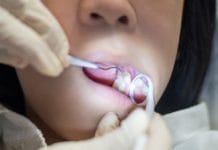Galvanized shock, which is also referred to as oral galvanism, oral electricity, electrogalvanism, or galvanic currents (and even called “battery mouth”) is a distinct, sharp, electrical zap of a sensation when two different metals touch a tooth. Anyone who has experienced this knows exactly what that feeling is.
Galvanism is defined as electricity produced by chemical action. Shock is the state of being so disturbed or a sudden or violent mental or emotional disturbance.
Galvanic shock rarely occurs in dentistry due to the current generation of restorative materials. However, some patients with older restorations can potentially experience galvanized shock.
A galvanized shock is when the presence of different metal alloys in the oral cavity influences induction and creates an adverse effect of an electrochemical reaction. The metallic restorations act as electrodes, while the saliva and crevicular fluid act as electrolytes. The saliva adds a wet, salty climate to transfer the energy to experience the painful shock.1
The Presence of Metal
Metal restorations have been used for ages due to ease of use, durability, hardiness to withstand chewing forces, and their cost-effectiveness. A wide range of materials are used in metal alloys, and metal alloys have changed in content over time. Metal restorations contain mercury, zinc, tin, silver, copper, and gold.
Patients with metal restorations have the above contents in their saliva more than patients who don’t have metal fillings.2 Metal materials are found in gold crowns, chrome cobalt partial dentures, amalgam restorations, nickel or iron-based orthodontic wires, silver solders, and titanium implants.
Each of these materials carries different levels of electrical potential.3 Metals naturally carry an electrical potential. When dissimilar metals interact, then there is the potential for a difference in electrical potential. A galvanic shock is when the different electrical current flows and promotes the zap.4
The current flows if a metal is connected to another metal, such as when a gold crown contacts an amalgam restoration. The current can flow between the two due to the difference in electrical potential, and that’s when the shock is felt.4
The Shocking Sensation
This shock often happens when different dentists use materials that differ. The specific metal, the quantity, and placement in the mouth determines if a galvanic shock will happen. Suppose a patient has had multiple dentists who have completed metal restorations in a patients’ mouth over time. In that case, there is a higher risk of having different metal contents contacting each other to cause a galvanic shock.
For example, titanium and high copper restorations are most reactive compared to titanium and gallium-based direct restorations. Also, a silver-based amalgam with chromium-cobalt or chromium-nickel alloy is more reactive; therefore, stainless steel develops a higher current density than gold or cobalt-chromium alloys when it contacts an amalgam restoration.5Amalgam to gold is the most common interaction for a galvanic shock. This sends the zap through the teeth and soft tissues.
The galvanic current not only passes through metal to metal but also through tissues to cause pain. Although some patients may feel a sharp pain at 10 mA and some not until 110 mA, it’s usually felt when galvanic currents exceed 20 mA. Pain is interpreted differently in people; however, in comparison, it would be like licking a fresh 9-volt battery. The current flow from galvanic cells could cause bone destruction 4,5
Galvanic currents depend on composition and surface area. As the size of the cathode (the gold) increases relative to the anode (the amalgam), the current density may increase. The larger cathode may enhance the corrosion of the smaller anode.6
Common occurrences of galvanic shock are:
- A gold crown contacting an amalgam restoration
- A silver utensil contacting a metal restoration
- A piece of aluminum foil touching a gold crown or amalgam restoration4
Symptoms to indicate oral galvanism are a metallic or salty taste, tingling, rashes, burning mouth, tooth sensitivity, and pain. The galvanic effect triggers the nerves in the teeth, especially if they’re exposed.7
Types of dental galvanism:
- An amalgam restoration opposed or adjacent to a gold crown. These dissimilar metals, in conjunction with saliva, creates an electric cell. When the two metals touch, the circuit is shorted, and the flow of electrical currents pass through the pulp, therefore instigating pain.
- A second potential pathway for these currents may happen between teeth in the same arch but not in contact with.
- The third potential is dissimilar metals coming into contact when the maxillary and mandibular teeth occlude.
- A fourth type is when two adjacent teeth have dissimilar metals, and the current flows from metal to metal through the dentin, bone, and tissue fluids of both teeth.8
A galvanic shock may happen at anytime the different metals encounter each other. It can happen while eating or when the mouth closes tightly, such as in grinding or clenching. It can also happen during hygiene treatment when using a scaler on a tooth with a metal restoration.
Oral galvanism accelerates corrosion in dental restorations. Although the corrosive process mainly occurs as electrochemical, it may also occur with fluctuations in temperature, pH, and food decomposition.3
Galvanic Corrosion
Corrosion is metal deterioration or surface damage in an aggressive environment. Corrosion may occur from moisture, atmosphere, acid or alkaline solutions, and oxidization. There are two classifications of corrosion: chemical, which is dry corrosion, and electrochemical, which is wet corrosion. Galvanic corrosion falls under the electrochemical type.10
Electrochemical corrosion occurs in the presence of water or another liquid electrolyte. Dissimilar metals form a galvanic cell in the oral environment. A galvanic cell is used to supply an electric current to transfer electrons through a redox reaction. The conversion is from a chemical to an electrical change.
When differing metal fillings contact each other, the cell is short-circuited. If the current flows through the dental pulp, pain is experienced, and the more anodic restoration will corrode.6 The higher the alloy’s corrosion rate, the greater the metal ion release and risk of the undesirable reactions in the mouth − pain.1 The electrical current passes through the oral tissues via the pulp, causing the pain. The resulting electrochemical potential develops an electric current that electrolytically dissolves the less noble material.10
Protection from corrosion is highly polished restorations, a coat of noble metal over the base metal in dental castings, using passivating metals, and using a coating with inorganic non-conductive components.10
Foil
This results from a galvanic shock that resembles a battery in the mouth with the electrical current stimulating the nerve endings. This only happens if there’s other metal in the mouth. The dissimilar metals, being the aluminum in the foil, create the electrochemical potential difference or voltage to spark the shock.
The current is conducted from a filling or crown into the tooth’s root, which sets off a nerve impulse then is sent to the brain, and the brain then interprets it as pain.11
Dental Metal Activity Meter
There are several meters to detect galvanism. A dental metal activity meter is used to measure galvanic current. It is used to measure electrical charges of restorations, crowns, and metallic appliances. A miltitester is used to measure milliamperes for electrical current or millivolts to measure the potential difference.7
Galvanized Shock Prevention
Nonmetal restorations are becoming more common, and oral galvanism has greatly subsided. The prevention of galvanized shock is to place the same metal fillings on opposing or adjacent teeth. Another way is to have composite restorations placed. Restorations made from combinations of glass and plastic are charge-free, therefore shock-free. If partial dentures are involved avoiding the clasps to rest on amalgam restorations will prevent a galvanized shock.4
Treatment of Galvanized Shock
If a galvanized shock is occurring, there are responsible and effective fixes. If the galvanized shock is occlusal, the filling or gold crown is adjusted, so there is no contact when chewing. Painting a coating or unfilled light-cured resin over the metal filling will break the metal contact, promote corrosion product build-up to break the circuit.
Another technique for relieving pain is placing a rubber dam strip between the contact of dissimilar restorations.7,9 If the metals involved become tarnished, the shock will cease. If the galvanized shock is interproximal, a more aggressive approach is to replace the restorations or crowns with similar metals or composite restorations.4
Unproven Suggestions
Some reports have suggested systemic implications may be present with galvanism shock. These complications include headaches, chronic fatigue, memory loss, deprivation, and irritability. It’s also been considered these complications may lead to disruptions in the central nervous system.
Other thoughts are that cellular changes from oral galvanism are comparable to those observed in oral squamous cell carcinoma.4 Yet other publications have recommended caution about stating that galvanism shock leads to systemic diseases and other conditions.7
Galvanic shock has become very rare in dentistry, although it used to be more common. New technology and growth of dentistry and restorative materials, it’s greatly decreased. When a patient does present with a galvanized shock, it’s usually the existence of older restorations. If it’s painful and irritating enough to the patient, making them aware of options to relieve any shock and pain will be comforting for them.
Before you leave, check out the Today’s RDH self-study CE courses. All courses are peer-reviewed and non-sponsored to focus solely on pure education. Click here now.
Listen to the Today’s RDH Dental Hygiene Podcast Below:
References
- Podzimek, S., Hána, K., Miksovský, M., et al. The Influence of Galvanic Currents and Voltage on the Proliferation Activity of Lymphocytes and Expression of Cell Surface Molecules. Folia biologica. 2008; 54(5): 146-50. Retrieved from https://pubmed.ncbi.nlm.nih.gov/19178813/.
- Procházková, J., Podzimek, S., Tomka, M., et al. Metal Alloys in the Oral Cavity as a Cause of Oral Discomfort in Sensitive Patients. Neuro Endocrinol Lett. 2006 Dec; 27(Suppl 1): 53-8.
- The Oral Galvanic Effect. (n.d.). Laser Dental Wellness Center-Fullerton. Retrieved from http://www.cdchealth.com/oralgalvaniceffect.html.
- Calcaterra, N. Dental Galvanism: Galvanic Shock and Your Teeth. (2016, November 30). Directions in Dentistry. Retrieved from http://directionsindentistry.net/dental-galvanism-galvanic-shock-teeth/#comments
- Zohdi, H., Emami, M., Shahverdi, H.R. Galvanic Corrosion Behavior of Dental Alloys. Environmental and Industrial Corrosion – Practical and Theoretical Aspects. (2012) Retrieved from https://www.ericdavisdental.com/biological-dentistry/symptoms-of-toxicity/galvanism/Galvanism-5.pdf.
- Galvanism. Craig’s Restorative Dental Materials. Science Direct. Thirteenth Edition. (2012). Retrieved from https://www.sciencedirect.com/topics/nursing-and-health-professions/galvanic-current.
- Oral Galvanism. (2014, November 10). Dental Gama Dental Social Network. Retrieved from https://dentagama.com/news/oral-galvanism.
- Galvanism Electrical Current with The Power to Destroy. (n.d.) Eric Davis Dental Science Based Biological Dentistry. Retrieved from https://www.ericdavisdental.com/biological-dentistry/symptoms-of-toxicity/galvanism/.
- Williamson, R. Clinical Management of Galvanic Current between Gold and Amalgam. Gen Dent. 1996 Jan-Feb; 44(1): 70-3. PMID: 8940574.
- Ashraf, M. (2015, October 10). Physical Properties of Dental Materials. Retrieved from https://www.slideshare.net/mujtabaashraf/physical-properties-of-dental-materials-by-dr-mujtaba-ashraf.
- Biting on Aluminum Foil Can be Painful. Why? (2001, February 2). How Stuff Works. Retrieved from https://science.howstuffworks.com/question564.htm












